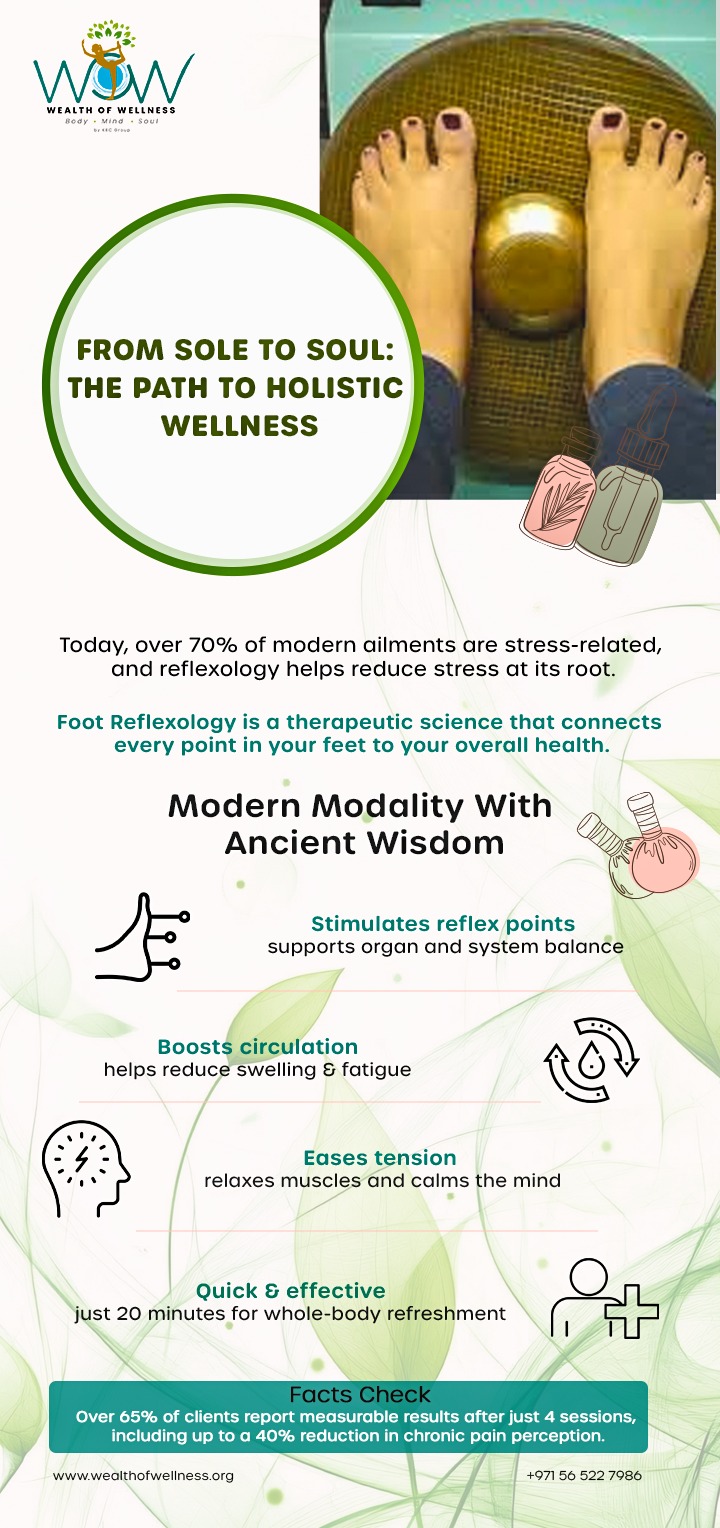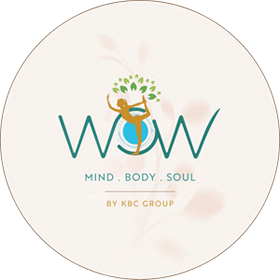
February 14, 2025
Foot Reflexology 101: How Your Feet Hold the Key to Full-Body Relaxation
Our feet do more than just support us—they’re an insight into our overall health and well-being. Foot reflexology, an ancient healing practice, uses targeted pressure points to reduce stress, improve circulation, and promote natural healing. As holistic wellness gains momentum, reflexology has become a go-to therapy for pain relief, relaxation, and overall health. Whether you’re looking to relieve tension, enhance energy flow, or simply unwind, this time-tested technique offers a natural way to restore balance and rejuvenate your body.Wellness is all about natural healing methods, including reflexology, and We aim to empower individuals with their usage. Understanding the science of foot reflexology is the starting point toward overall well-being in your life-wellness therapies to relieve tension, help circulation, and promote health.In this comprehensive guide, we’ll explore:
- What foot reflexology is and why it’s effective
- How it differs from a foot massage
- The key benefits of foot reflexology points
- Different types of foot reflexology
- What to expect in a professional reflexology session
What is Foot reflexology?
Foot reflexology is a powerful therapeutic technique that stimulates the body’s organs and systems by applying targeted pressure to specific areas of the feet. These reflex points correspond to different organs, helping to restore energy flow, promote healing, and support overall well-being.With roots in Traditional Chinese Medicine (TCM), ancient Egyptian healing practices, and Ayurveda, foot reflexology has been used for thousands of years to encourage natural balance and vitality. Unlike a standard foot massage that mainly relieves muscle tension, reflexology works on deep nerve centers and pressure points, activating the body’s innate ability to heal and harmonize.We use foot reflexology in our wellness programs including meditation, yoga, and other healing practices like Physical Wellness and Emotional Wellness.How foot reflexology works
With over 7,000 nerve endings linked to different organs and systems, your feet can reveal vital signals about potential imbalances in the body. A skilled reflexologist can relieve tension, improve circulation, and activate the body’s natural healing process through gentle yet precise pressure on these reflex points. This holistic approach promotes relaxation and supports better health and well-being from the ground up.Important foot reflexology points and their benefits
Every area of the foot corresponds to a particular body organ or function. Their stimulation relieves pain, enhances relaxation, and promotes better health.1. Big toe – Brain and head
The big toe connects with the brain, head, and pituitary gland. Pressure here may enhance clarity of thought, and concentration, and relieve a headache or migraine. Reflexology along the big toe is also of help to those individuals facing stress anxiety or sleep disorders.2. Ball of the foot – Heart and lungs
The ball of the foot corresponds to the heart and lungs. Massaging in that area helps increase circulation, improve lung function, and ensure proper oxygen flow in the body. Reflexology here is useful to treat asthma, congestion, or breathlessness.3. Arch of the foot – Digestive system and liver
The arch connects to the stomach, liver, pancreas, and intestines. Pressure applied during reflexology can stimulate digestion support liver detoxification and relieve bloating, constipation, or acid reflux. People suffering from any form of digestive discomfort can benefit from regular reflexology sessions targeted at this area.4. Heel – Lower back and intestines
The heel of the foot connects with the lower back, sciatic nerve, and intestines. Reflexology applied to this area can help relieve lower back pain and digestive discomfort, and support colon health. If you have problems with back pain or inflammation that could somehow prove to be aggressive, perhaps stimulating this reflex zone can be enough to elicit an observable relief.By stimulating targeted reflex areas on the foot, healing reflexology allows energy blockages to melt off, yielding a natural healing process in the entire body.Difference Between Foot Reflexology and Foot Massage
Although foot reflexology and foot massage both provide relaxation and relief, they have contrasting techniques, goals, and effects between them.Foot massage is mainly concerned with soothing tired muscles, enhancing blood circulation, and alleviating soreness. Various techniques such as kneading, rubbing, and stroking are used to help relax the feet. A foot massage can be enjoyed by many as part of a spa experience or for short-term relief from tired feet.Conversely, foot reflexology utilizes pressure on certain reflex zones in the foot that correspond to various areas of the body therapeutically, stimulating nerve pathways, relieving energy blockages, and kick-starting the body’s self-healing processes. While a foot massage only works on muscle systems, foot reflexology affects internal organs, energy flow, and the nervous system.If you’re looking for relaxation of muscles, a foot massage works. However, if you want more profound benefits of healing beyond the feet, foot reflexology is the more holistic option.What Are The Benefits of Foot Reflexology?
Foot reflexology isn’t just about relaxation. One of its approaches focuses on deep healing within the entire reliable. Weekly reflexology treatments will grant the whole body relief as it has so many proven benefits for physical, emotional, and mental health.1. Increased Stress and Anxiety Reduction
Foot reflexology lowers levels of cortisol through certain pressure point stimulation, which is what the body needs to be able to relax and recover from stress. For stress reduction, read our detailed stress management techniques.2. Simulates Regular Circulation
With good blood flow, the oxygen and other nutrients will now reach every cell more efficiently, which will help lessen fatigue and swelling.3. Eases Chronic Pain
Foot reflexology is often used as a pain-managing approach, with many people using it to help relieve headaches, migraines, joint pain, and backaches.4. Increases Digestive Process
The various reflex zones located on the bottom of your foot connected to your stomach and intestines can help mitigate bloating, constipation, and even acid reflux.5. Improves Quality of Sleep
The calming of the nervous system due to reflexology is a great remedy for insomnia and promotes deep sleep.6. Strengthens Immunity
Through lymphatic drainage stimulation, it helps in the elimination of toxins and promotes immune health.
What to Expect During a Professional Foot Reflexology Session:
If you have never had foot reflexology done to you before, you might be wondering how it goes during the session carried out by the professional. Be it a wellness centre or a specialized place, an important aim is that every reflexology session is meant to relax deeply and heal.The key way to experience this is:1. Consultation – Understanding Your Needs
Immediately before the foot reflexology session, the practitioner endeavours to understand the medical history of the client through this consultation. They talk about the lifestyle and wellness goals. For instance, they may survey:- Do you experience chronic pain, stress, or sleep issues?
- Have you had any recent injuries or surgeries?
- Do you suffer from digestive issues, headaches, or hormonal imbalances?
- Are there any specific areas of discomfort you want to address?
2. Foot Wash & Warm-up- Preparation for Relaxation
After a brief consultation, you’d have your feet washed and sanitized. Various items might be used depending on the reflexologist, including:- Wrapping with a warm towel to relax the muscles of the feet
- A soothing foot soak with essential oils or herbal salts
- Lightfoot massage to prepare for deeper pressure
3. Pressure Application-Stimulating Reflexology Points
This is the main phase where the reflexologist uses targeted pressure at specific reflex points on your feet that correspond to various areas of your body.- The thumb walking technique where your reflexologist applies pressure using small circular movements of the thumbs along different foot zones.
- Press and hold method- In this method, the reflexologist applies sustained pressure to key areas to aid in releasing energy blockages.
- Knuckle rolling- Knuckle rolling or tool-assisted massage in which the reflexologist rubs various parts to stimulate deeper points.
- Mild sensitivity in some areas, which can indicate tension or energy blockages.
- A warming or tingling feeling indicates greater circulation.
4. Deep Relaxation- This is for the Body to Respond
This is quite surprising but one of the great effects of foot reflexology is this deep relaxation that sneaks in during the session. Many clients report:- A sense of lightness or warmth in the body
- Less tension or anxiety in the muscles
- Improved breathing as well as circulation
- Some fall asleep during the whole therapy!
5. The After-effects-What it’s Like to Feel
Once done, you will feel relaxed, refreshed, and rejuvenated. Notable mentions include:- Increased energy levels
- Sense of lightness or reduced pain
- Better digestion and circulation
- A deep, restful sleep this night.

